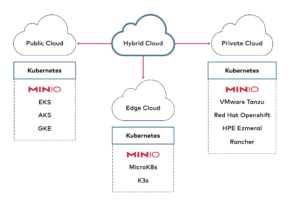
MinIO, Now Worth $1B, Still Hungry for Data

(Studio-M/Shutterstock)
MinIO was founded in 2014 near the peak of the Hadoop craze with what seemed like an outlandish idea: Build an open source object storage system based on Amazon S3. Eight years later, with a $1 billion valuation following today’s $103 million Series B round led by Intel Capital with participation by SoftBank, the idea doesn’t seem so crazy anymore.
As the original creator of the Gluster File System, Anand Babu Periasamy was no stranger to distributed storage systems. With a degree in engineering, Periasamy and his engineers hacked together a system for storing huge amounts of data in a global namespace, which was eventually installed in a supercomputer at the Department of Energy in 2005. Red Hat subsequently bought Gluster for $136 million in 2011.
But when he co-founded MinIO five years later, there was no guarantee that the new generation of object storage systems, such as AWS’s Simple Storage Service (S3), would become the dominant storage system. It was a big bet with no guarantee it would pay out, particularly with the hype surrounding the Hadoop market and the huge valuations that companies like Cloudera and Hortonworks were generating.
But as the Hadoop hype bubble popped–first slowly, then all at once–Periasamy’s bet started to look better. Object storage systems, and Amazon S3 in particular, emerged as the best place to reliably park large amounts of data (roughly defined as anything over 1PB). Combined with the Kubernetes orchestration engine, object storage based on S3 (as well as S3 itself) soon became the center of big data’s gravity. That shift to cloud-native tech like object storage and Kubernetes was officially cemented in 2019, when Hadoop’s stock finally collapsed.
But here’s the thing: MinIO isn’t just focused on the cloud. Yes, MinIO sported a Kubernetes operator, which the company says makes it ridiculously easy for even non-technical folks to spin up MinIO clusters in the cloud. But the cloud isn’t the end-all, be-all for MinIO. For the Palo Alto, California company, the focus is all about data.
“We always knew the bulk of the world’s data is going to be produced everywhere, not inside AWS,” says Periasamy, who goes by AB. “Inside AWS, only a tiny amount of data will be produced compared to the whole world’s data. And our goal was to be the world’s data store.”
Despite the sophistication of the MinIO system, including reliability and availability features required by some of the most demanding global enterprises, the entire MinIO binary is just 100MB, which enables it to be deployed practically anywhere, including ARM chips, autonomous vehicles, and embedded devices.
“For us to do a land grab, we have to be everywhere,” Periasamy says. “We didn’t even differentiate public, private, and edge. If there is data, we need to be there.”
Developing Growth
Periasamy boldly set out to “solve storage” when the MinIO software became generally available four years ago. By the looks of it today, he may be getting close.
Today, MinIO boasts of 756 million Docker pulls, with an average of more than 1 million new Docker pulls per day. The object storage system, which is distributed freely under the GNU AGPL v3 license, has more than 11 million active deployments, the company says. The offering runs on all the major clouds and is the underlying data persistence layer for a host of databases and streaming data systems.
The company’s commercial activity is also showing signs of growth. In the past year, annual recurring revenue has increased by more than 200%, the company says, and the customer count has grown by a similar amount. What’s remarkable is that all this growth has occurred without a dedicated sales team.
According to MinIO’s Chief Marketing Officer Jonathan Symonds, that won’t change in the wake of the $103 million Series B.
“All of our traction is inbound. It has been from the beginning,” he says. “That’s not going to change. You’re not going to see us hire new sales people and hire new engineers, open up offices in foreign lands. We have a model that we have not perfected, but we understand well at this point, and we’re going to continue to add fuel to that engine. It’s worked out very well for us and we just think that we can accelerate things even more on a go-forward basis.”
With more money dedicated to marketing, Symonds will be able to scale up his operation and get the MinIO word out to a wider audience. He will be directing the company’s message of radical simplicity of PUTS and GETS in big data storage to one group in particular: developers.
“Developers are the engine of value creation in the enterprise today, and so we want to focus on that audience,” Symonds says. “We’ve made great strides in expanding that audience. You can see that in the MinIO operator for Kubernetes. You can see that in the MinIO console, ways that you can now operate large scale data infrastructure without having to spell Kubernetes. You can set up object storage as a service in just a handful of clicks.”
A New Data Platform
Object storage is the base of a new data platform that mid to large organizations are adopting to power a range of applications, from transaction processing in the cloud to machine learning at the edge. According to Periasamy, MinIO is well positioned to capitalize on the shift to data as the centerpiece of the business strategy.
“Data is the core asset of these companies and organizations, and the data infrastructure starts at a few petabytes, and then it starts accelerating beyond 10 petabytes,” he tells Datanami. “They’re all basically trying to do some AI/ML, analytics around it. Whether they call it data lake or data infrastructure–everyone calls it different names. But from our point of view, all we care is you have a few petabytes of data to begin with. That’s the right time for us to talk to them.”
These customers will have different workloads that require different types of databases to serve the data effectively. MinIO won’t be the primary data storage layer that applications interact with in many situations, says Periasamy, a 2018 Datanami Person to Watch. But MinIO will accel as the underlying data store beneath these databases.
“There are many kinds of database and there is a good reason for it,” he says. “A graph database can never be a good key-value like Cassandra. Cassandra will never be better than SQL or even Postgres. They all solve different problems in a different way.”
Databases and streaming data systems, like Kafka, will expose different data access mechanisms, indexing, and querying methods, Periasiamy says. Developers will pick and choose the best system for their particular needs. The good news for MinIO is that many of these databases will select the object store as the ultimate persistence layer.
“If I pick one of them as a winner, I would be missing out in a big way,” Periasamy says. “A LAMP stack type model won’t emerge. Instead, it will be more like there is a foundational piece like Kubernetes and object store, and that layer above, there are different APIs. Some would even do GraphQL for serving some web applications. Some could use a Elasticsearch type or a Presto type. I think that there will be a portfolio of a large array of products. We will embrace them as an ecosystem.”
Objectively Fast
Concerned about the slowness of object stores? The idea of object stores being slow actually isn’t true, Periasamy says.
“That object stores are slow is actually a myth created by SAN and NAS vendors,” he says. “Object store was always fast, and it was the primary storage in the cloud. Cloud was born with AWS S3, then came everything else, from Snowflake to PowerBI to Azure ML to BigQuery. Everything. You name it, all of these modern databases, data processing frameworks in the cloud, are built on object storage.”
With today’s speedy flash drives, throughput shouldn’t be a problem, Symonds says. “In fact, we just published our new NVMe benchmarks earlier this month [based on a cluster of 32 nodes of NVMe] and it’s 325 GBs a second on reads and 165 GBs a second on writes,” he says. “So at that speed, anything is in play.”
For Vikas Parekh, the managing partner at SoftBank Investment Advisers, the bet on MinIO is all about getting a foot in the door of the emerging data stack.
“High performance, multi-cloud object storage represents a foundational component in the modern software stack,” Parekh says in a press release. “We believe that MinIO has established itself as the leader for a diverse set of workloads from AI/ML, advanced analytics, databases and modern applications. We are delighted to partner with Anand Babu Periasamy, Garima Kapoor and the team as they ramp up commercialization of the technology.”
Related Items:
MinIO Bolsters Enterprise Chops with K8s Integration
MinIO Enjoying Role in Emerging Cloud Architecture
Solving Storage Just the Beginning for Minio CEO Periasamy






























